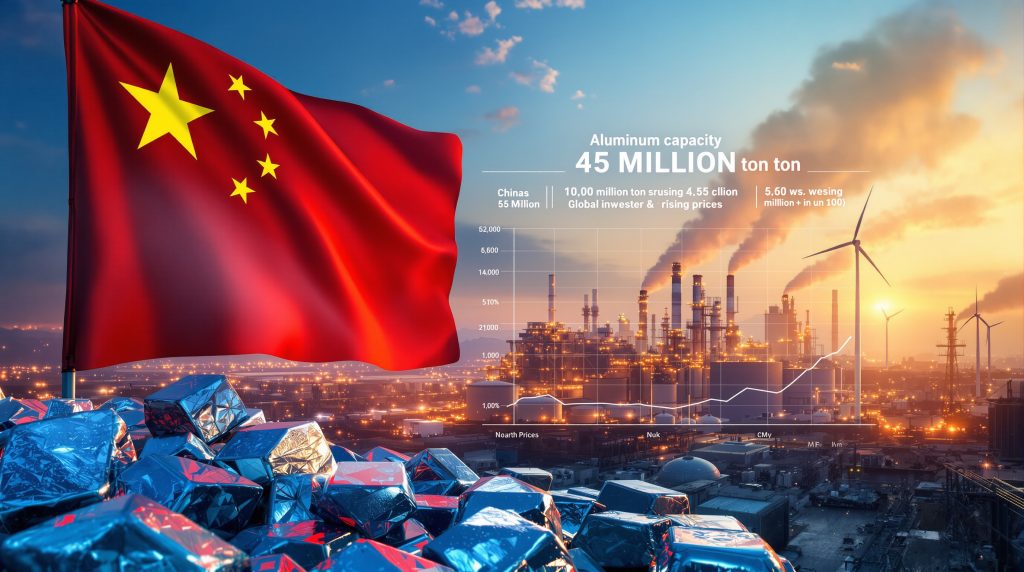How is China Limiting Aluminum Production?
The 45 Million Ton Production Cap
China has implemented a strict national ceiling of 45 million tons per year on primary aluminum production, a policy established to address overcapacity and environmental concerns. Despite growing domestic and global demand, this cap has remained firmly in place. As of mid-2025, China's production has reached approximately 44.5 million tons annually, according to AZ Global consultancy data, pushing against this regulatory ceiling and fundamentally altering global aluminum scrap price assessments.
China's aluminum sector has undergone remarkable growth, expanding from just 4 million tons in 2002 to over 43 million tons in 2024, capturing approximately 60% of global production. This trajectory, however, is now hitting a government-imposed wall that shows no signs of being raised.
Capacity Replacement Policies
The Chinese government enforces a strict "replacement before expansion" approach, requiring older facilities to be decommissioned before new capacity can be approved. This policy creates a zero-sum game for producers looking to expand or modernize operations.
New smelters must meet stringent environmental standards, including:
- Maximum energy consumption of 13,000 kWh per ton of aluminum
- Enhanced emissions control technology
- Prohibition of new projects in heavily polluted regions
While operators can achieve minor production increases by raising smelter amperage, these technical adjustments provide limited additional output beyond the mandated capacity ceiling.
Geographic Redistribution Strategy
China is strategically relocating aluminum production from eastern coastal provinces to western and southwestern regions with:
- Greater access to renewable energy sources (hydropower, solar, wind)
- Lower population density
- Proximity to bauxite project benefits
Key destination provinces include Inner Mongolia, Yunnan, and Xinjiang, where environmental impacts can be better managed and energy costs potentially reduced through access to renewable power sources.
Why is China Restricting Aluminum Production?
Environmental Protection Imperatives
The aluminum industry is highly energy-intensive, with smelting operations traditionally relying on coal power. China's production limits aim to:
- Reduce carbon emissions by up to 65 million tons annually
- Decrease air pollution in densely populated regions
- Support China's carbon neutrality goals for 2060
- Improve energy efficiency across the industrial sector
These environmental considerations have become increasingly important as China balances industrial growth with ecological sustainability transformation and international climate commitments.
Strategic Resource Management
China's aluminum strategy extends beyond simple production caps to include:
- Conservation of domestic bauxite reserves
- Reduced dependence on imported raw materials
- Promotion of secondary aluminum production (recycling)
- Development of higher-value aluminum products for export
This comprehensive approach represents a shift from quantity-focused production to a more strategic, value-oriented industrial policy.
Industrial Restructuring Goals
The government is using production limits to drive industrial transformation through:
- Elimination of outdated production facilities
- Consolidation around larger, more efficient producers
- Technology upgrades across the supply chain
- Shift toward higher-value manufacturing
This restructuring aims to position China's aluminum industry at a more advanced level in the global value chain while addressing longstanding issues of overcapacity and environmental impact.
What Impact Do These Limits Have on Global Markets?
Shifting Trade Patterns
China's production constraints are reshaping global aluminum flows in significant and measurable ways:
- Decreasing exports of semi-finished aluminum products (down 9% in the first seven months of 2025)
- Increasing imports of primary aluminum (up 11% to 1.5 million tons in first seven months of 2025)
- Growing imports from Russia (nearly doubled year-over-year)
- Reduced availability of aluminum on international exchanges
These trade pattern shifts signal a fundamental change in China's position within global aluminum markets, transforming from a persistent net exporter to a potential net importer.
Price Implications and Market Tightening
The market is experiencing structural shifts due to China's production ceiling:
- LME aluminum prices hovering around $2,700 per metric ton in 2025
- Analysts projecting potential rise to $3,000+ per ton
- Exchange inventories declining to approximately 700,000 tons (down from over 3 million tons four years ago)
- Emergence of potential global supply deficits for the first time in decades
According to Citi analysts, the market is "sleepwalking into the biggest deficits in 20 years," suggesting a paradigm shift from historical oversupply to potential shortage.
Supply Chain Vulnerabilities
China's production limits expose several vulnerabilities in global aluminum supply:
- Limited production growth outside China due to high energy costs
- Declining smelter capacity in Western nations
- Potential closure of major facilities like South32's Mozambique smelter
- Increasing dependency on Indonesian capacity expansion
These vulnerabilities are particularly concerning given aluminum's growing importance in energy transition technologies, including solar panels and electric vehicles.
How Are Other Countries Responding to China's Production Limits?
Indonesian Capacity Expansion
Indonesia has become the focal point for new aluminum production capacity:
- Chinese companies investing in offshore smelting operations
- Projected capacity additions of 2.3-7 million tons by 2030
- Challenges in securing sufficient energy supplies
- Competition with other industrial sectors for resources
However, realistic assessments from analysts like Citi suggest Indonesian capacity may reach only 2.3 million tons per year by 2030, far below the paper pipeline of 7 million tons, due to energy constraints and financial challenges at current aluminum prices.
Western Production Strategies
Western nations are pursuing various approaches to aluminum security:
- United States implementing 50% tariffs on Chinese aluminum imports under President Trump's administration
- Potential restart of idled North American smelting capacity
- European producers struggling with high energy costs
- Australia focusing on maintaining existing production levels
Despite these efforts, primary aluminum production outside China has been in long-term decline, partly due to China's historical export dominance.
Supply Diversification Efforts
Global aluminum consumers are adapting to the new market reality through:
- Long-term supply contracts with non-Chinese producers
- Investment in recycling and secondary production
- Development of aluminum alternatives where feasible
- Strategic stockpiling of critical supplies
These adaptations represent a recognition that the era of abundant, low-cost aluminum may be drawing to a close.
What Does the Future Hold for Aluminum Markets?
Potential Market Deficits
For the first time in decades, analysts project the global aluminum market may face genuine supply shortages:
- Citi forecasts "the biggest deficits in 20 years"
- Structural shift from persistent oversupply to potential undersupply
- Limited ability to increase Chinese production beyond current levels
- Challenges in rapidly expanding production elsewhere
This represents a fundamental change for a market historically defined by excess rather than scarcity.
Price Trajectory Scenarios
Market analysts are revising long-term price outlooks based on supply constraints:
- Potential for sustained prices above $3,000 per ton
- Higher price floors needed to incentivize new production
- Increased commodity market volatility during supply transitions
- Premium pricing for low-carbon aluminum products
Citi expects aluminum prices will need to rise above $3,000 per metric ton and stay there to prevent global shortages, a significant shift from historical pricing dynamics.
Technological and Recycling Developments
The industry is responding to production constraints through innovation:
- Accelerated development of low-carbon smelting technologies
- Expanded aluminum recycling infrastructure (targeting 15+ million tons in China by 2027)
- Improved scrap collection and processing systems
- Advanced alloys that reduce primary aluminum requirements
Secondary aluminum production, which requires only about 5% of the energy needed for primary production, is likely to see accelerated investment as primary supply tightens.
How Do China's Aluminum Policies Compare to Other Metals?
Contrasting Approaches Across Metals
China's approach to aluminum differs significantly from its policies for other metals:
- More stringent production caps than for steel and copper
- Greater emphasis on environmental factors than for rare earths
- Stronger geographic redistribution than for zinc or lead
- More comprehensive industrial restructuring than for precious metals
These differences reflect aluminum's unique position in China's industrial ecosystem, combining high energy intensity with strategic importance.
Integrated Resource Strategy
China's aluminum policy is part of a broader metals and minerals strategy that includes:
- Securing upstream resources through international investments
- Developing downstream manufacturing capabilities
- Balancing environmental protection with industrial development
- Maintaining strategic influence in global supply chains
This integrated approach seeks to maximize China's resource security while minimizing environmental impacts across the metals sector.
Comparative Market Impacts
The effects of China's aluminum limits contrast with other metal markets:
- Creating tighter global supply conditions than in copper
- Driving more significant trade flow changes than in nickel
- Generating greater price support than in zinc
- Producing more immediate market effects than in rare earths
These differential impacts stem from aluminum's specific supply-demand dynamics and China's outsized role in global production.
What Are the Environmental Implications of China's Aluminum Limits?
Carbon Emissions Reduction
China's aluminum production constraints deliver significant environmental benefits:
- Potential reduction of 65-85 million tons of CO₂ annually
- Decreased coal consumption for electricity generation
- Accelerated transition to renewable solutions in mining
- Improved air quality in industrial regions
Given that aluminum smelting is one of the most energy-intensive industrial processes, these emission reductions represent a substantial contribution to China's climate goals.
Energy Efficiency Improvements
The policy drives technological advancement in energy efficiency:
- Average energy consumption reduced from 14,500 kWh/ton to under 13,000 kWh/ton
- Implementation of heat recovery systems
- Deployment of advanced process controls
- Integration of smart manufacturing technologies
These efficiency gains help mitigate the environmental impact of remaining aluminum production while potentially reducing operational costs.
Circular Economy Development
Production limits encourage greater focus on aluminum recycling:
- Secondary aluminum requires only 5% of the energy of primary production
- Expanded collection infrastructure for used aluminum products
- Advanced sorting technologies for mixed aluminum scrap
- Development of closed-loop manufacturing systems
As primary production tightens, the economic incentives for recycling increase, potentially accelerating China's transition toward a more circular aluminum economy.
FAQs About China's Aluminum Production Limits
When did China first implement its aluminum production cap?
China first established production limits for aluminum in 2017 as part of broader supply-side reforms aimed at reducing industrial overcapacity and environmental pollution. The current 45 million ton cap has been maintained through successive five-year plans and industrial policies, with increasing enforcement rigor over time.
Can Chinese producers exceed the production cap temporarily?
While the 45 million ton limit applies to installed capacity, actual production can temporarily exceed this level through operational adjustments like increasing amperage at existing smelters. However, these measures face technical limitations and regulatory scrutiny, providing only marginal additional output beyond the mandated ceiling.
How does China enforce its aluminum production limits?
China enforces production limits through multiple mechanisms including:
- Mandatory environmental impact assessments
- Energy consumption quotas
- Production permits and licensing
- Regular inspections and monitoring
- Financial penalties for non-compliance
This multi-layered enforcement approach ensures the production cap remains effective despite market pressures.
Will China increase its aluminum production cap in the future?
Current policy signals suggest China will maintain its 45 million ton cap through at least 2027. Any future adjustments would likely be tied to improvements in energy efficiency, emissions reduction, and alignment with broader climate goals rather than simple capacity expansion.
How do aluminum production limits affect China's export policies?
China has complemented production limits with export policy changes, including:
- Removal of export tax rebates for primary aluminum
- Stricter quality controls on exported products
- Promotion of higher-value aluminum exports
- Potential export restrictions during domestic supply shortages
These policy adjustments support China's shift from quantity-focused exports to quality-oriented industrial development.
Market Context and Future Outlook
Historical Perspective
Past aluminum market crises have typically resulted from oversupply rather than shortage. In the 1990s, the collapse of the Soviet Union flooded global markets with excess aluminum. In the early 21st century, China's massive production growth created persistent oversupply conditions. The potential for supply deficits represents a novel situation for market participants accustomed to abundance.
Supply-Demand Balance
Global demand is receiving a significant boost from aluminum's expanding role in energy transition applications, including solar panels, electric vehicles, and energy-efficient buildings. With China's production growth effectively capped and limited capacity expansion elsewhere, the market's traditional supply cushion is disappearing.
Investment Implications
The changing aluminum market fundamentals may require significant adjustments to investment strategies and business models throughout the value chain:
- Higher and more volatile prices reshaping purchasing strategies
- Increased focus on securing long-term supply agreements
- Greater premium for recycled material
- Renewed interest in developing primary production outside China
These changes will likely drive investment toward both recycling infrastructure and carefully selected primary production projects with access to low-cost, renewable energy.
Ready to Track the Next Major Mineral Discovery?
Discover how significant mineral finds can generate substantial returns with Discovery Alert's proprietary Discovery IQ model, which instantly notifies investors of major ASX mineral discoveries and turns complex data into actionable insights. Explore historic examples of exceptional outcomes by visiting Discovery Alert's dedicated discoveries page and position yourself ahead of the market.




